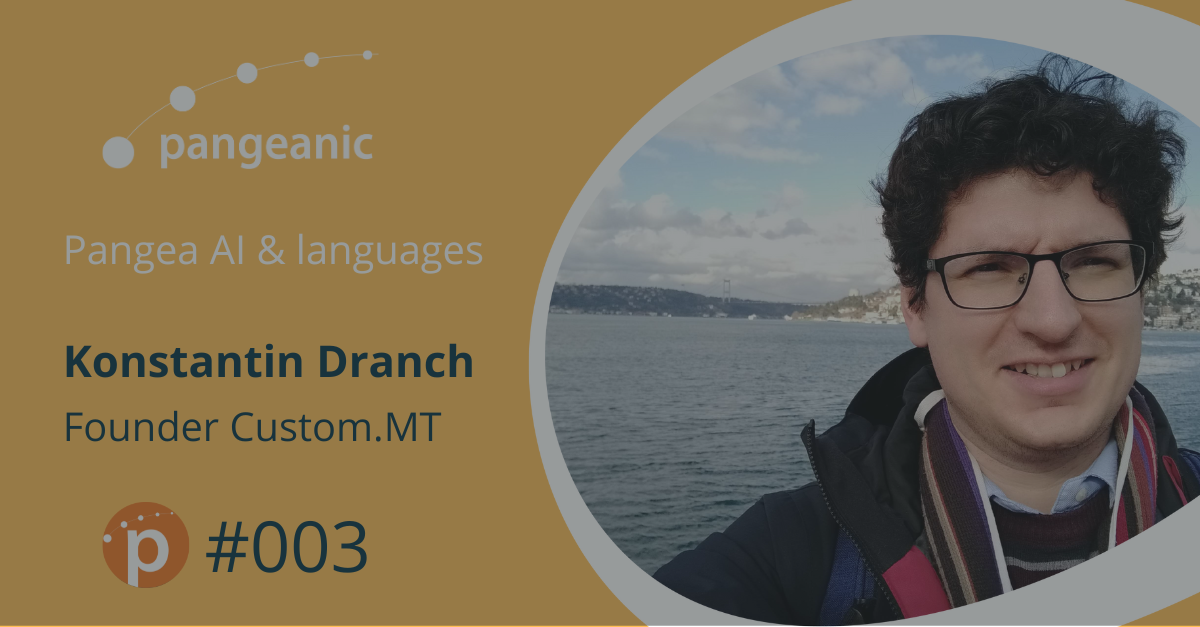Konstantin Dranch: "The world's machine translation engines process more text than all the human translators on Earth combined could translate in 20 years."
Konstantin started his career in the localization industry 12 years ago. His first job was in the marketing and strategy department of a translation technology company. He later worked at MIMS Insights, where he headed the research department. During his time there, he mapped the industry, researching what technologies were being used on the market.
After that, he started his first freelance business, focusing on providing answers to the translation and localization needs that companies around the world might have.
At the time, the big players on the market had their eyes on customizing machine translation models. Google and Microsoft were working on machine translation engines being able to learn product names and improve language style and accuracy, especially for scientific or marketing content and anything else that companies or organizations needed.
It was then that Konstantin, together with a colleague, created Custom.MT (MT stands for machine translation). But not everyone understood the concept; shortly after setting up the company, they received an email from the Maltese authorities asking: "Why are you using Malta's domain?"
Two years have passed since its inception and its work is focused on customizing and implementing different machine translation models for corporate environments.
Manuel Herranz, CEO of Pangeanic, interviewed Konstantin Dranch in this third podcast of "Pangea AI & Languages." When asked how he sees the translation and localization industry with respect to artificial intelligence, he replied: "The relationship between translators and machine translation is one of love and hate. At first, there was a lot of fear that with machine translation, robots would replace humans. Everyone wondered what would happen. In the early days, maybe 5-10% of translation volume was done by machines, but as quality has improved over the last five years, translators have begun to understand that they don't need to do the work from scratch because the robot can do that bit, and all they have to do is edit it. " One thing is clear to him: "It saves time and money."
According to the figures, "the world's machine translation engines process more text than all the human translators on Earth combined could translate in 20 years." Although Konstantin acknowledges that "in economic terms, it's the human translator that still makes all the money; machines represent maybe 2% of the market in cash terms."
For him, there is a clear explanation: "We are still wary because no one wants to have their medication description translated by a machine without any human review."
Konstantin acknowledges that in this fast-growing scenario of machine translation, "you have to rely on it because there is no other option. Different predictive model forecasts are being performed to see if machine translation can be trusted, not only at the human level but also at the algorithmic level."
Governments themselves are actively adopting machine translation. "In Canada there is a Ministry of Translation and they use machine translation with an indigenous language in order to protect it."
Machine translation as a way to protect endangered languages
Machine translation is serving as a technology for preserving endangered languages. Konstantin gave his opinion on whether he believes that content can be produced with the same quality as human translators, for example, when it comes to idiomatic expressions, movie subtitles, literature, and other creative genres: "It's an ongoing discussion because the economic opportunity for making a machine translation engine for minority languages is not great. Why spend a million dollars on something that won't yield any return?"
According to Konstantin's data, "at the moment, Google covers 135 languages. Facebook recently launched an open-source model covering 200. But how many languages are there across the globe? Approximately six thousand."
It is clear to him that brands do not invest in a language that has very few speakers. "Companies are trying to solve the problem by having multilingual models that understand a language, even if the quality is not excellent."
The European language industry conducted a survey in 2022 in which it acknowledged that 65% of companies in this industry believe that there is room for improvement in the quality of neural machine translation. Konstantin recognizes the vast opportunities that neural machine translation offers companies and public administrations that want customized engines: "This data is highly scientific and specialized because clients are demanding and ask for quality controls, revisions, etc. In some cases, the translation companies own the data, and in others, it is the clients who own it."
Custom.MT's new project: machine translation for the field of climate change
Konstantin explains that Custom.MT is working on implementing different types of artificial intelligence in the field of machine translation: "We train different models, compare them, run the evaluations, and help our clients. We're developing a lot of software to implement those ready-made models directly into the applications that people use, without them noticing the machine translation."
One of the projects they are currently focused on is what they call the "climate change translator." They were able to obtain their data through a collaboration with a major climate change organization. "We want to analyze much more data and be able to make the world's most accurate machine translation engine to help promote climate change information in different languages. These days, a lot of information on climate change is being produced with incredible quality, but it is very limited in scope. Our goal is that it can be indexed by Google and translated into 40, 50 or 100 languages, with high precision and without the need to use a million translators."



